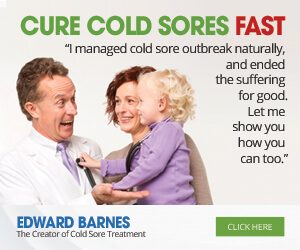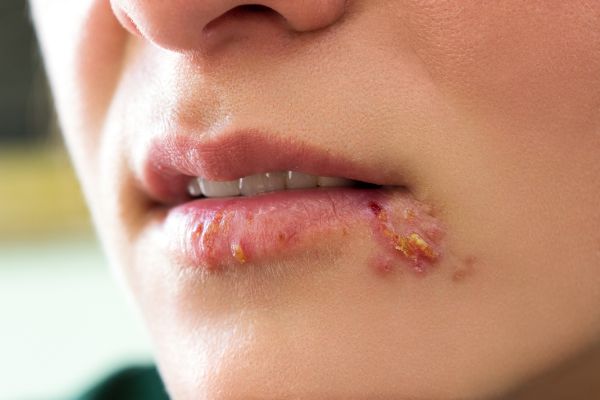
Explore cold sore stages. Understand the herpes virus better to treat it effectively!
If you want to treat a disease or an ailment effectively then you really need to understand the symptoms, stages of its infection and what causes it. When it comes to cold sores infection, symptoms generally lasts 2 weeks.
Before you take Cold Sores Treatment, you should know cold sore stages. It helps you to identify the way the cold sore looks as it goes through each stage of formation. This helps you be prepared and combat the same accordingly.
What Causes A Cold Sore or Fever Blisters?
Fever blisters, or cold sores, are caused by a virus called Herpes Simplex Virus (HSV-1 or HSV-2). Usually, this herpes virus (HSV-1) often causes sores in and around the mouth and lips, tongue, cheeks and nasal region, and even on the eye (facial herpes). There is a second type called HSV-2 that causes genital herpes.
Cold sores or fever blisters are quite painful. They can develop inside the mouth as well as outside it. Usually, several such blisters appear together in a cluster. This condition is also referred to as gingivostomatitis and makes you feel embarrassed.
More than 90 percent of adults are infected with Herpes Simplex Virus. It is very common that an individual can have cold sore symptoms more than one time a year, whereas some individuals have more than 4 cycles per year.
Unfortunately, more than 50 percent of people keep getting the cold sores by the time they are in kindergarten. Moreover, it is reported that over 20% of cold sore sufferers that have HSV antibodies are prone to recurrent attacks in their life.
Sometimes cold sores symptoms might be so mild or none at all that not everyone will experience the same symptomatic cold sores. Though herpes is not life-threatening, none can escape the discomfort and social embarrassment during cold sore stages.
Cold Sore Stages That You Should Know About:
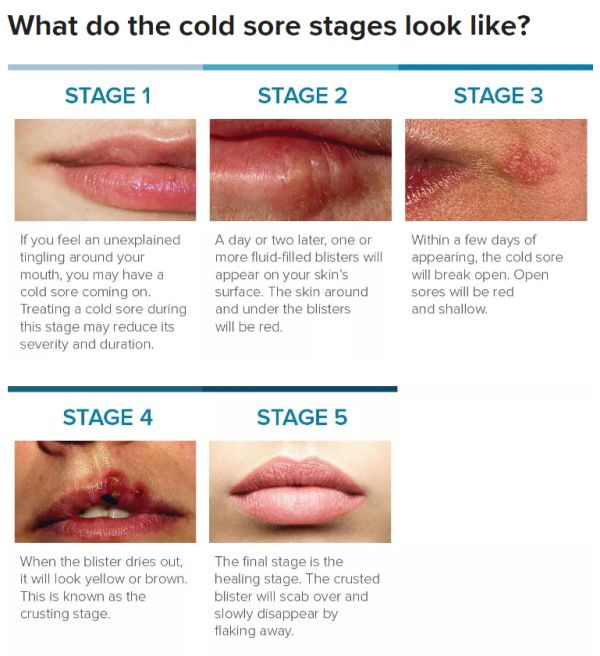
Just happened to browse Healthline and found this graphic on What do the cold sore stages look like? Hope this illustration will be of invaluable benefit to you.
Fever blisters, or cold sores, start with tingling sensation at the site of infection. These blisters are small at first; soon they enlarge causing itching, irritation, and soreness. Within a few days, they burst and become encrusted, and they usually disappear within a week.
When you go through this article of cold sore symptoms, you can easily make out the different stages of a cold sore infection that spreads 8-10 days period. This will help you to act quickly at the first stage to prevent the virus from proceeding further.
Cold Sore Stage 1 – The Tingle Stage (Days 1 – 2):
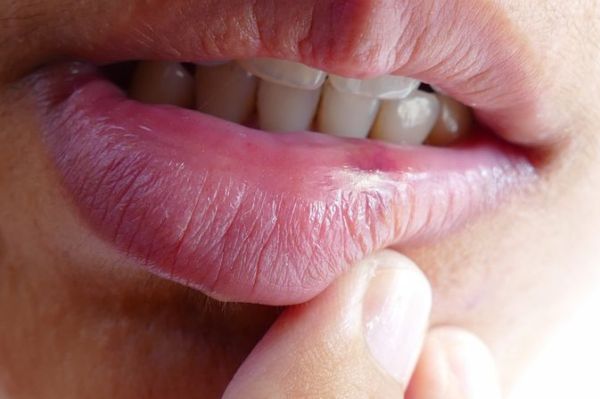
The first attack of the virus may pass unnoticed or may cause illness resembling influenza and painful ulcers in the mouth and on the lips. The virus lies dormant in nerve cells, but whereas in some people it gets occasionally reactivated when the person is exposed to hot sunshine or cold wind, has a cold or other infection or is feeling rundown. Women are more likely to develop cold sore symptoms during their periods.
Herpes virus lives, become active and moves in your nerve fibers to the target area to start its activity. This will be the first attack of herpes virus. The virus will replicate and get ready to shoot the sight under opportunistic conditions.
At this moment, you will sense the first few symptoms like unexplained tingling, burning, soreness, tautness, and itching in the area where the outbreak will ultimately appear.
This tingle stage (also known as prodrome stage) will last for a few hours to 2 days. If you act quickly at this stage, you can prevent the virus to proceed further. Apply ice at the first sign of tingling for about 15-20 minutes. Repeat it frequently throughout the day. Apply Vitamin E for quick relief.
You can apply Aloe vera gel known to be an effective antiviral herbal drug for the treatment of oral herpes disease.
Cold Sore Stage 2 – The Blister Stage (Days 2 – 4):

After a day or two, the cold sore will have a visible sign of a blister. Usually, it appears like a pimple or red swollen bumps at the target area. These bumps often multiply and are quite painful to touch. This is when the blisters are filled with fluid. And the surrounded skin becomes red and swollen.
The fluid-filled blister is the result of the herpes virus waking up. As the body begins to fight back, the fever blisters appear in and around the mouth and lips.
You should never squeeze a cold sore blister no matter how tempting it is to scratch. If you pop or squeeze a cold sore then it may lead to several problems, including new infections, scarring, and of course more cold sores.
Squeezing a cold sore blister can result in the interruption of its healing process and several other recurrent contagious infections, such as herpetic whitlow and viral keratitis.
Cold Sore Stage 3 – The Weeping Stage (Day 4):
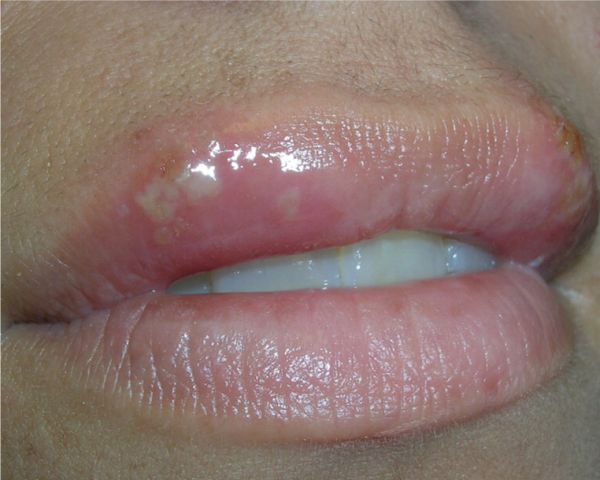
Cold sores can burst open and the fluid filled in oozes out causing infection at a new site or spreads the infection to a person who comes in contact. Incidentally, fever blisters are most contagious during this time.
This can be the most painful and contagious state of a cold sore outbreak. Open sores will be red and shallow. In this weeping stage (also known as ulcer stage), the immune system starts working on the site and thus there’s an inflammation response (redness, swelling and tenderness).
As said earlier, don’t try to pick at the sores. The sore transforms into an ulceration. In order to prevent the virus from spreading, wash the cold sore with mild soap and water.
Cold Sore Stage 4 – The Scabbing Stage (Days 5 – 8):
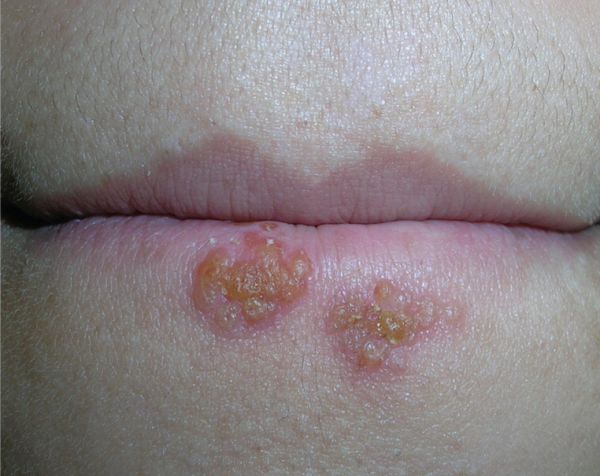
According to Elaine C. Jong & Dennis L. Stevens (the authors of Netter’s Infectious Diseases E-Book), the ulcer dries up and becomes darker to form a scab. The scabbing will look yellow or brown. It often cracks and can bleed, so don’t try to peel off the scab. Wait until it falls off naturally. Moisturizing the scab using emollients containing aloe vera or zinc oxide ointment may prevent itching to a great extent at this stage.
Replacement of the damaged cells begin. At this scabbing stage (also known as crusting stage), you may continue feeling mild fever, headache, running nose and painful lymph nodes. These symptoms subside with the passage of each day.
Cold Sore Stage 5 – The Healing Stage (Days 8 – 10):
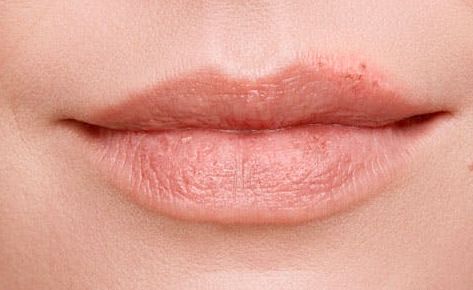
At this stage, the process of healing is at its peak and a scab will fall off slowly revealing the new skin. A small pink spot will appear at the site of infection showing the process of healing.
The redness must have gone before you are totally clear of the blister. In most cases, sore lesion resolves fully without scarring.
How Long Does It Take For A Cold Sore To Go Away?
According to Barbara E. Gould & Ruthanna M Dyer (the authors of Pathophysiology for the Health Professions E-Book), cold sore stages and symptoms last for a few days to 2 weeks and usually starts healing on its own within a few days. Though you cannot cure cold sore, you can reduce its frequency and limit the duration of its occurrence.
The cold sore symptoms vary from person to person but as discussed the most prominent ones are the pain, itching, and burning. Do remember that the virus that causes cold sores is infectious. Thus it can infect others and also spread to other parts of the human body.
Over To You …
As the herpes virus is the causative agent, no treatment is effective until date. However, some people find relief by applying lip balm and other home remedies as it prevents further outbreaks.
In conclusion, the most common symptoms are reported above in a timeline manner. At a given time, most of the cold sore sufferers exhibit similar symptoms. However, it should be noted that slight differences could also be observed.
If one suffers from less number of symptoms then it is quite possible to treat cold sores at a faster rate. Here’s the best resource on the internet dealing with Cold Sore Treatment naturally. It helps you to totally eliminate and prevent outbreaks.



